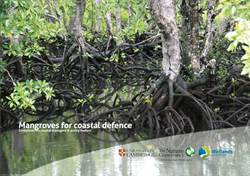
Mangroves Provide Measurable Risk Reduction Benefit to Coastal Communities from Storm Waves and Flooding
-
Coastal resilience
-
Coastal wetland conservation
-
Integrated delta management
A new guidebook on mangroves as a coastal defence finds that mangroves can reduce risk from a large number of coastal hazards. The role of mangroves in coastal defence has been widely promoted since the tsunami that struck South-East Asia in 2004. Yet, the level of protection provided by mangroves has been subject to debate.
The “Mangroves for coastal defence: Guidelines for coastal managers & policy makers” launched today by The Nature Conservancy and Wetlands International at a symposium hosted by the Zoological Society of London convening mangrove experts from across the globe, provides an in-depth analysis on the role that mangroves play in defense against waves, storms, tsunamis, erosion and sea level rise. Working with the University of Cambridge to review hundreds of scientific papers, the guide book outlines a practical approach for coastal decision makers.
“Mangroves are an incredibly important habitat, providing essential services for both people and nature. They are fish factories, carbon stores, water purifiers, and produce timber and fuelwood,” said Dr Mark Spalding, senior marine scientist at The Nature Conservancy and lead author of the report, during his keynote speech at the Turning the Tide symposium. ”The guidebook outlines how mangrove forests serve as natural infrastructures to reduce wave energy and storm surge even during major storms, lessening the risk to coastal communities.”
Mangroves have been lost in many areas through conversion to aquaculture ponds and agricultural land or urban expansion. The costs of these losses to local human populations are felt in terms of greater vulnerability to natural hazards and decreased fish catches. Avoiding such losses in the future is critical, and restoration is increasingly occurring in mangrove nations world-wide.
The guidebook illustrates exactly how mangroves can rapidly reduce incoming waves to diminish threats from erosion and inundation in a clear and concise way for planners and managers. It highlights how wide mangrove belts can be effective in reducing the flooding impacts of storm surges occurring during hurricanes (also called cyclones or typhoons) and can lower tsunami heights, helping to limit loss of life and damage to property in areas behind mangroves. Besides dampening waves, the dense aboveground roots of mangroves help to bind and build soils, reducing erosion. Over time mangroves can even build up soil heights, countering the impacts of rising seas.
Coastal managers need to get a good understanding of risk and vulnerability in their specific shore prior to determining what role mangroves can play,” said Dr. Femke Tonneijck, Wetlands International. “This guidebook gives them the tools to assess their risk context, to define hazard-specific mangrove management interventions and whether mangroves can be a stand-alone solution or need to be combined with other risk reduction measures to achieve a desired level of protection”.
“The case for sustainable management and for restoration is rock solid” says Spalding. “What we need to do now is to make sure that case is heard amongst communities, planners and decision-makers. Once we understand the full value of mangroves, and the costs of loss, it is critical to build the framework for them to remain and flourish. That means incorporating mangroves into broader coastal zone management planning and providing the tools and expertise for restoration.”
For more information
Femke Tonneijck
Programme Manager, Wetlands International
+31 318660937
[email protected]
Mark Spalding
Senior Scientist, The Nature Conservancy
+44 1223334459
[email protected]

